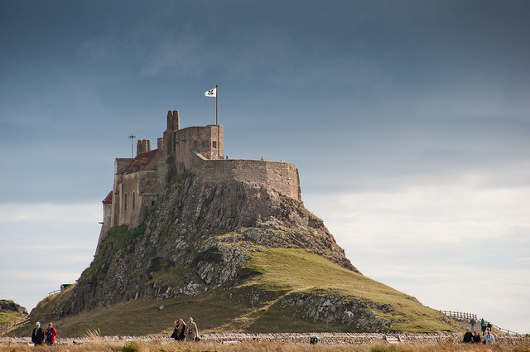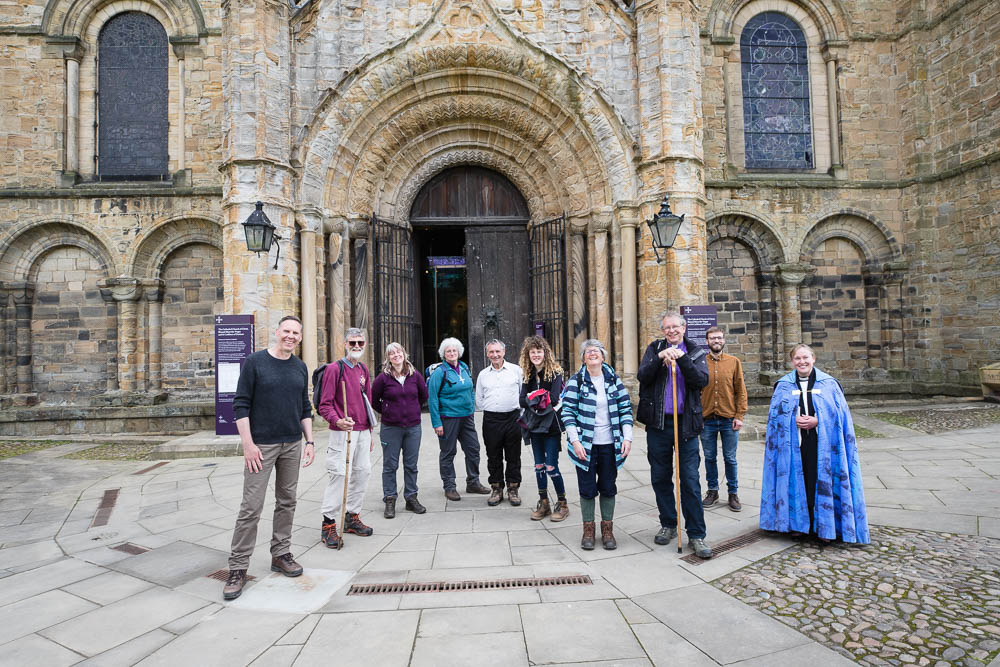Your #DigiPilgrim Online Pilgrimage Itinerary
In 875 a small group of monks from the monastery on Lindisfarne Island set out on a heart-wrenching mission. Fleeing the Vikings, they carried the island’s most treasured possessions: the bones of their beloved St Cuthbert, and the beautifully illustrated volume of gospels dedicated to him, the Lindisfarne Gospels. Seven years later their quest for sanctuary ended at a priory at Chester-le-Street near Durham, and many years later again, at the site of Durham Cathedral. Nearly 1200 years later the intricately calligraphed Gospels are still with us. We’re on a journey to see them, and we’re looking forward to you joining us!
Here’s the original announcement
Here’s a podcast on the value of taking a pilgrimage
The Itinerary
On Sunday September 15 my friend DJ and I are setting out to retrace some of the steps those monks took, in the #DigiPilgrim Online Pilgrimage. We’ll walk the 100 miles from Lindisfarne to Durham where the Lindisfarne Gospels are currently on display, and you’ll get to follow along with our daily videoblogs, tweets, photos and reflections.
Here’s the journey we’ll take each day:
Day 1: Sunday 15th- Lindisfarne to Bamburgh
Walk: We’ll depart Holy Island for the mainland at 6am during low tide and walk to Belford (14 miles) and then on to Bamburgh (5 miles)
Bamburgh is the historic centre of the kingdom of Northumbria. It was from here that King Oswald invited the Iona monks to send missionaries to this region, and where Aidan and his monks subsequently came in 635AD to establish a church near the present day St Aidan’s Church
Sites: Parish church of St Aidan; monument to St Aidan; historic castle
Day 2: Monday 16th- Bamburgh to Craster
Walk: Bamburgh to Craster (14 miles)
Craster is famous for its dramatic coastal scenery, the ‘Craster Kipper’, and the impressive 14th century Dunstanburgh Castle ruins
Sites: Farne Islands (including Inner Farne, St Cuthbert’s hideaway); Beadnell, with the remains of a medieval Chapel of St Ebba (St Oswald’s sister)
Day 3: Tuesday 17th- Craster to Amble
Walk: Craster to Warkworth (13.5 miles,), then on to Amble (5 miles)
Amble is home to a massive puffin colony (1 mile offshore at Coquet island), a big sundial, and a 19th century Church of St Cuthbert (every Northumberland town needs one!)
Sites: Howick Stone Age Hut, perhaps oldest house in England (around 8,000 BC?); Warkworth Castle (mentioned unfavourably in Shakespeare’s Henry IV Part II); a Norman church (of St Laurence) stands on the site of an 8th century church founded by King Ceowulf who eventually became a monk on Lindisfarne himself
Day 4: Wednesday 18th- Amble to Newbiggin-by-the-Sea
Walk: Amble to Newbiggin-by-the-Sea (13 miles)
Newbiggin is another of Northumberland’s scenic coastal towns, with two historic churches and the UKs (if not the world’s) first permanent offshore artwork – ‘Couple’ by Sean Henry
Sites: The Church of St Mary the Virgin, Woodhorn – reputed to be the oldest church in Northumberland (parts of the building date to 700 AD) and associated with King Ceowulf and St Cuthbert
Day 5: Thursday 19th- Newbiggin-by-the-Sea to Whitley Bay
Walk: Newbiggin-bt-Sea to Whitley Bay (14.5 miles)
Sites: We’ll tell you as we see them!
Day 6: Friday 20th- Whitley Bay to Jarrow
Walk: Whitley Bay to Jarrow (15 miles)
Jarrow is the birthplace of the Venerable Bede, famous for his 7th-century history book of English Christianity
Sites: Ruins of Tynemouth Priory and Castle; St Paul’s monastery (682) – Bede’s home
Day 7: Saturday 21st- Jarrow to Roker
Visit: Bede’s World (museum)
Walk: Jarrow to Roker (12 miles)
Sites: Bede’s Cross on the Roker coast
Day 8: Sunday 22nd- Roker to Durham
Visit: Possible 8am service at St Andrew’s Church, the masterpiece of renowned early 20th century architect Edward Schroeder Prior
Walk: Roker to Durham (17.8 miles) via St Peter’s Church, Monkwearmouth, near where the young Bede spent some years
Sites: Church of St Mary and St Cuthbert, Chester-le-street: it was at this site that the Lindisfarne monks came in 883AD with the bones and relics of St Cuthbert, head of St Oswald and the Lindisfarne Gospels. It was here that Aldred’s Anglo-Saxon translation was added to the gospels (circa 950 AD). One of only three fascimile but beautiful copies of the Lindisfarne Gospels are found in this parish church.
Visit: Evensong in Durham Cathedral (3.30pm)
Day 9: Monday 23rd- Lindisfarne Gospels
Visit: The Lindisfarne Gospels exhibition, Palace Green Library, Durham University – the culmination and reward of our journey!
***
Get Involved
We hope this virtual pilgrimage will become a devotional opportunity for you to connect with God and reflect on your life right where you are. To take part:
- Subscribe to the BigBible blog, where all the action will happen
- Follow us on Twitter: @bigbible @sheridanvoysey @djkonz (me and BigBible are on Facebook too) and share your questions and thoughts along the journey
- Start following the #DigiPilgrim hashtag
- Discover more about Lindisfarne, Durham Cathedral and the Lindisfarne Gospels
- Reflect on this story of Jesus meeting two people along their own journey
Join us for what will be a great adventure.
Sheridan and DJ





